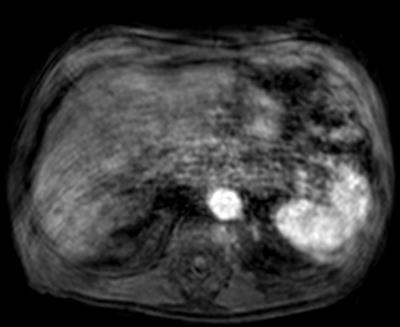2004
Assessment of interrater agreement and reliability for characterization of respiratory motion related artifacts at gadoxetate disodium-enhanced liver MRI1Department of Diagnostic and Interventional Radiology, Hannover Medical School, Hannover, Germany, 2Department of Diagnostic and Interventional Radiology, University Hospital of Bonn, Bonn, Germany, 3Department of Medical Biometry, Informatics and Epidemiology, University Hospital of Bonn, Bonn, Germany, 4Department of Diagnostic and Interventional Radiology, Clinic of the Goethe University, Frankfurt, 5Department of Diagnostic and Interventional Radiology, Klinikum der Stadt Ludwigshafen, Ludwigshafen, Germany, 6Department of Radiology, University Hospital of Bern, Bern, Switzerland, 7Division of Radiology and Nuclear Medicine, Kantonspital St. Gallen, St. Gallen, Switzerland, 8Department of Radiology, Asklepios Klinik Altona, Hamburg, Germany, 9Instiute of Diagostic and Interventional Radiology, Städtisches Klinukum Karlsruhe, Karlsruhe, Germany, 10Department of Diagnostic and Interventional Radiology, University Hospital of Tuebingen, Tuebingen, Germany, 11Department of Radiology, University Hospital Regensburg, Regensburg, Germany, 12Department of Diagnostic and Interventional Radiology, University Hospital Leipzig, Leipzig, Germany, 13Department of Radiology, Neuroradiology, Ultrasounnd and Nuclear Medicine, Krankenhaus der Barmherzigen Brueder, Trier, Germany
Synopsis
In
this prospective multicenter study, interrater agreement and reliability for
characterization and grading of respiratory motion artifacts related to the
injection of gadoxetate disodium were evaluated. Interrater agreement and
reliability for scoring of motion artifacts in the arterial phase was excellent
among experienced abdominal radiologists from different European tertiary
referral centers with an intraclass correlation coefficient of 0.983 and 0.985,
respectively. Characterization and grading of respiratory motion artifacts can
thus be performed with a high level of confidence, which is a prerequisite for
assessing the incidence of this phenomenon in larger multicenter studies.
Purpose
Recently, an association has been described between the intravenous injection of gadoxetate disodium and motion artifacts in the arterial phase of the contrast dynamic, which may have destructive effects on arterial phase imaging1,2. The exact pathophysiology of this phenomenon is still unknown3 and the reported incidence throughout the literature is not consistent covering a wide range between 2.4 and up to 18%1,4. The purpose of this study was first, to characterize motion-related artifact in gadoxetate disodium-enhanced liver MRI examinations and second, to assess interrater agreement and reliability regarding the grading of this artifact in a large multicenter setting.Methods
This prospective multicenter study was IRB-approved. 11 board-certified radiologists from 11 different European centers independently evaluated 40 gadoxetate disodium-enhanced MRI datasets. The datasets were selected by two radiologists of the coordinating study center and included respiratory motion artifacts of variable severity. All images were acquired on a 1.5T scanner using bolus detection technique and standard dosing of 0.025 mmol/kg gadoxetate disodium injected at a flow rate of 1.5 ml/sec. Motion artifacts in the arterial phase were assessed on a 5-point scale. Every reader had knowledge about the differentiation of motion artifacts from other causes of image degradation. Interrater agreement and reliability were calculated using the intraclass correlation coefficient (ICC) and Kendall coefficient of concordance (W), with p<0.05 deemed significant.Results
Severe motion artifact, defined as a mean motion score ≥4 in the arterial phase was observed in 12 patients. In these specific cases, a motion score ≥4 was assigned by all readers in 75% (n=9/12 cases). Interrater agreement, defined as to which extent different readers assigned the same precise motion score, and as assessed by means of the ICC was 0.983 (95% confidence intervals 0.973-0.990; p<0.0001). The Kendall W for assessment of interrater agreement was 0.865 (p<0.0001). Both values indicated almost perfect interrater agreement regarding the rating of motion artifact on arterial phase gadoxetate disodium-enhanced MRI. Interrater reliability, assessing the extent to which readers could consistently distinguish between different motion scores, was very high as well with an ICC of 0.985 (95% confidence intervals 0.978-0.991; p<0.0001).Discussion
In this multicenter study, we observed a high interrater agreement and reliability for the assessment of motion artifacts at arterial phase gadoxetate disodium-enhanced MRI. Due to the possible detrimental effects of respiratory motion on dynamic liver MRI, robust characterization and scoring in large multicenter studies is essential for evaluation of this unaccounted for phenomenon.Conclusion
Characterization and grading of respiratory motion from other causes of artifact can be performed with a high level of interrater agreement and reliability, which is crucial for assessing the incidence of this phenomenon in larger multicenter studies.Acknowledgements
noneReferences
1. Davenport MA, Caoili EM, Kaza RK, et al. Matched within-patient cohort study of transient arterial phase respiratory motion-related artifact in MR imaging of the liver: gadoxetate disodium versus Gadobenate dimeglumine. Radiology. 2014;272:123-131.
2. Pietryga JA, Burke LM, Marin D, et al. Respiratory motion artifact affecting hepatic arterial phase imaging with gadoxetate disodium: examination recovery with a multiple arterial phase acquisition. Radiology. 2014;271:426-434.
3. Huh J, Kim SY, Yeh BM, et al. Troubleshooting Arterial-Phase MR Images of Gadoxetate Disodium-Enhanced Liver. Korean J Radiol 2015;16(6):1207-1215.
4. Luetkens JA, Kupczyk PA, Doerner J, et al. Respiratory motion artifacts in dynamic liver MRI: a comparison using gadoxetate disodium and gadubutrol. Eur Radiol. 2015;25(11):3207-3213.
